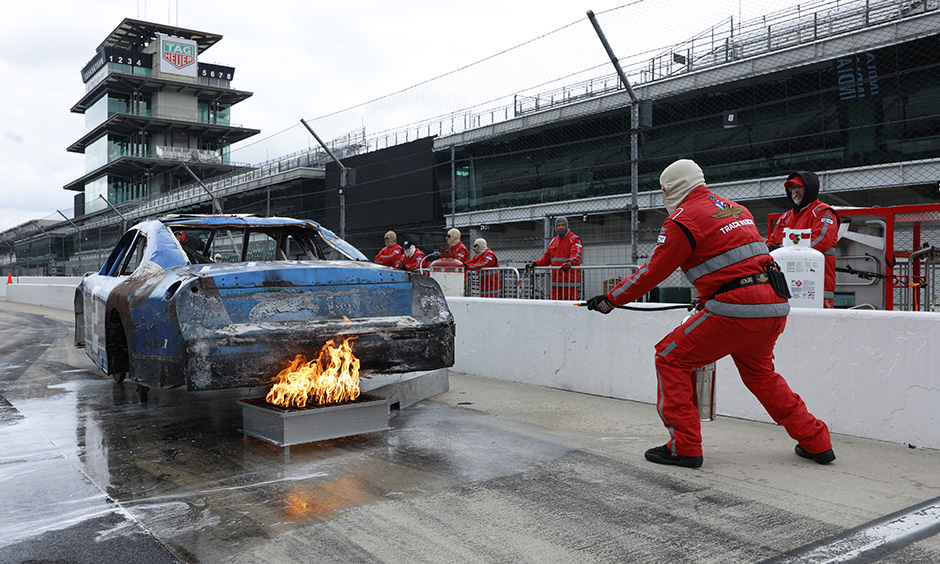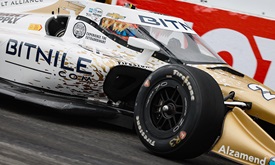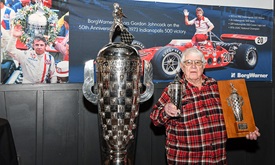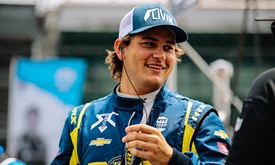United in Safety: INDYCAR, NASCAR, IMSA Teams Train at IMS
APR 26, 2023
Indianapolis Motor Speedway (IMS) hosted an unprecedented event April 22-23 as INDYCAR, IMSA and NASCAR officials joined forces for the first time for two days of training with AMR and the track’s safety teams.
An estimated 200 first responders and medical personnel representing eight states across the Midwest participated in specialized safety training for motorsports, with a goal of uniform communication and procedures. The initial day was focused primarily on classroom instruction, which took place in the DEX Imaging Media Center at IMS.
Then, gloves were on and sirens went off as cars were set ablaze as six stations were set up around and within the facility, spanning from the 2.5-mile superspeedway that will play host to the NTT INDYCAR SERIES for the 107th Running of the Indianapolis 500 presented by Gainbridge on May 28, along with the 2.439-mile, 14-turn road course layout that will host the NTT INDYCAR SERIES, NASCAR Cup Series, NASCAR Xfinity Series and IMSA WeatherTech SportsCar Championship in 2023.
Those attending received training in these areas:
- Pit Lane Burn/Injured Person Scenario
- Car Rollover Scenario
- Holmatro Extraction Tool Training
- Tire Barrier Restoration
- INDYCAR Vehicle Familiarization/Extraction
- Live Burn Scenario
- IMSA Vehicle Familiarization/Extraction
Dr. Julia Vaizer, the director of medical services for INDYCAR and IMS, was among those observing and learning from the respective activities.
“This is the first time when everybody gets to share their knowledge into one big established phenomenal racetrack,” Vaizer said. “I know IMSA has their own team. I know NASCAR has their team, but every single team, all three of these, are different in the way they operate.
“They have different code names. The ‘yellow, yellow, yellow’ is unique to us, or maybe it's not. What’s a pace car? What's a chase car? What's a physician car? What's the 1,200 (code)? What's the 99 (code)? So, those are all very unique terminologies that come with each series. And it's good for everybody who works to understand because if you're not speaking the same language, we're not really getting anywhere.”
Roy Spillman, manager of track services for IMSA, which makes its long-awaited return to IMS Sept. 15-17 with the Tirerack.com Battle on the Bricks, expressed the importance of the local safety personnel understanding the nuances of how each series works but also know how to work within each respective series’ system.
For instance, IMSA carries two Porsche Cayenne vehicles and two Chevrolet Silverado trucks. Spillman and a team member occupy one of the Porsches, while the other – Chase Two – carries a team member and one track doctor. The trucks hold three team members each, while also carrying rescue tools and fire suppression equipment. In total, IMSA brings between nine or 10 people before incorporating local personnel.
“IMSA is coming back to IMS for the first time in a long time, and we're bringing some new equipment with us,” said Spillman, who was helping with instruction in one of the garages near Gasoline Alley. “Things that the team here hasn't seen before: the prototype, the GTP car, which will be a hybrid car. We weren't able to get a GTP car here, but we've got last year's DPi car, which is very similar; the cockpit is the same. The bodywork is pretty close the same, so we can train them on that. We also brought one of the Lamborghinis along.
“We're getting them familiar with the cars so when we do come back here in September for the race, it's not going to be totally brand-new. They’ll have a concept of what we expect from the IMSA side. And if they do have to approach the car on the track, they will be ready to do it, safely and efficiently.”
According to Tim Baughman, senior director of track safety and medical service for the NTT INDYCAR SERIES, there has been more networking over the last five years than the previous 50 years in terms of emergency services.
“Most of us are very dedicated to trying to improve motorsports safety in all venues, not just these large venues that host major series,” Baughman said. “We have folks from Eldora here, we have some folks from other short tracks here. They work their local short track and then come here for the major events and work. So, they're going to take some of this knowledge base back to them. They learn their basics; first response, whether it's emergency medicine, firefighting and even the wrecker guys in recovery, they come here and then get a specialty to apply that to motorsports.
“It's a different challenge. It's different types of cars, different types of fuels, different environments. And it does it evolve all the time. These cars are changing every year, and so every year there's new material to learn and there's new material to stay on top of.”
Mark Nelson, track services coordinator and track liaison from NASCAR for IMS and Lucas Oil Raceway in nearby Clermont, also believes this is a prime opportunity for each series to learn from one another in an overall effort to maximize safety in motorsports.
“There is a lot that we can learn from, and I can already see a few things that I think each series has, whether it's just a small modification or completely adopting something totally new,” Nelson said. “There has been some of that crosspollination, certainly. And that's the goal, to make us better. It's to make the track service workers at each facility better, promote motorsport safety across the board and motorsports, as well.”
Jason Penix, senior director of event and track operations for IMS, said the training program took roughly six months to put together, with the concept building momentum just before last Christmas. Penix also recognized the support from AMR and IU Health for their respective roles in the first-of-its-kind endeavor. Overall, he was very impressed by watching all three sanctioning bodies unite for something that benefits the entire sport.
“I don't know any other time in motorsports that these major sanctioning bodies have come together and done it at this level,” Penix said. “I think that's the most impressive thing is that there's no barriers between INDYCAR, NASCAR, IMSA and IMS, and every other racetrack. Everybody's working toward the same goal, and that's a motorsports safety and improving that as much as we can. That's all why we're here.”



















